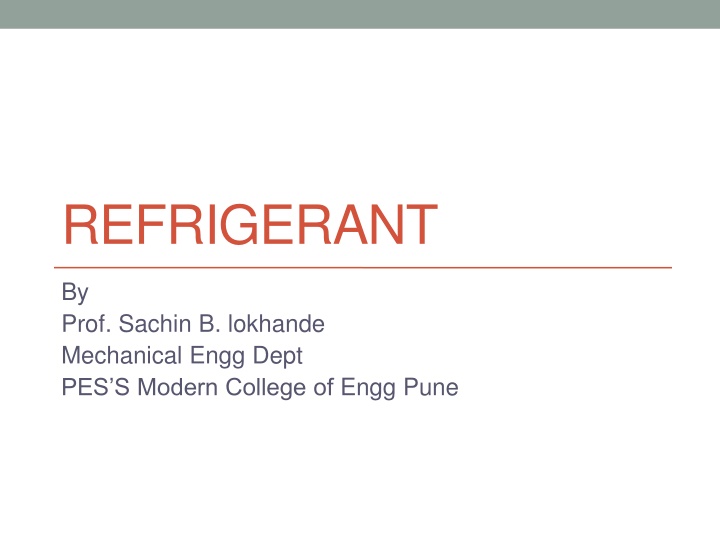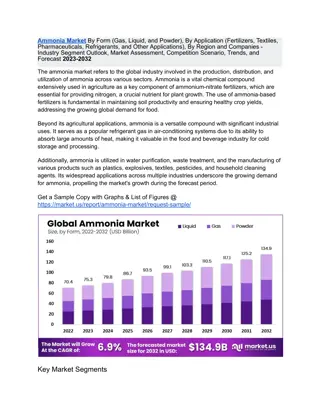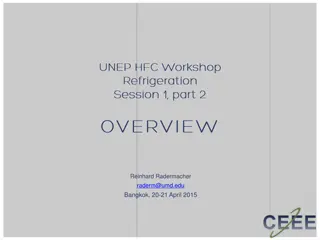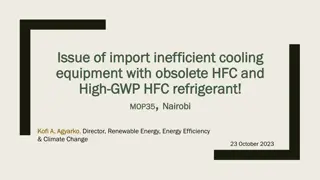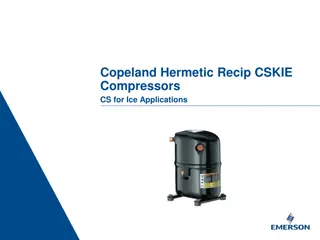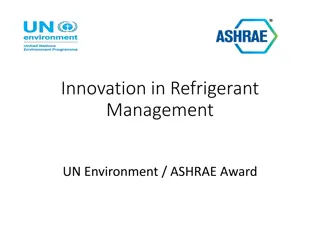Overview of Refrigerants: Definition, History, and Classification
Refrigerants are crucial for heat transfer in refrigeration systems. Explore the history, types, selection criteria, and more in this comprehensive guide to refrigerants.
Download Presentation

Please find below an Image/Link to download the presentation.
The content on the website is provided AS IS for your information and personal use only. It may not be sold, licensed, or shared on other websites without obtaining consent from the author.If you encounter any issues during the download, it is possible that the publisher has removed the file from their server.
You are allowed to download the files provided on this website for personal or commercial use, subject to the condition that they are used lawfully. All files are the property of their respective owners.
The content on the website is provided AS IS for your information and personal use only. It may not be sold, licensed, or shared on other websites without obtaining consent from the author.
E N D
Presentation Transcript
REFRIGERANT By Prof. Sachin B. lokhande Mechanical Engg Dept PES S Modern College of Engg Pune
CONTENT Definition HISTORY CLASSIFICATION PROPERTIES DESIGNATION SYSYTEM FOR REFRIGERANT COLOR CODING CONCLUSION
What is Refrigerant? Refrigerant is the fluid used for heat transfer in a refrigerating system that absorbs heat during evaporation from the region of low temperature and pressure, and releases heat during condensation at a region of higher temperature and pressure.
HISTORY OF REFRIGERANTS :- Natural refrigerants:- 1) Ice blocks 2) Using nocturnal cooling 3) Use of evaporation Artificial refrigerants :- 1) In 1835, Jakob Perkins use ethyl ether as the refrigerant ( b.p= 30 c). (if air mixed forms an explosive gas). 2) In 1874, Raowl Piolet designs the first sulphur dioxide based system. (forms H2SO4 when gets moisture). 3) In 1885, Fraunz Windhausen builds the first to use co2 in Germany. (high operating pressure ). 4)In 1920, iso-butane based domestic refrigerator ( highly flammable), General Electric first introduce Kelvinator refrigerator. 5) In 1930, Introduction of CFCs
CLSSIFICATION OF REFRIGERANTS Primary Refrigerant Secondary Refrigerant Primary refrigerants are those which can be directly used for the purpose of refrigeration Secondary refrigerant are first cooled by primary refrigerant the use for refrigeration purpose Not undergoes phase change Ex : Water, Brine Undergoes phase change Ex: R134a R22 etc
REFRIGERANT SELECTION CRITERIA:- Thermodynamic and Thermo-physical properties Environmental and safety properties, and Economics
Classification of Primary refrigerant PureFluids Mixture 1) AZEOTROPIC- R500,R502,R504 2) ZEOTROPIC Synthetic 1) CFCS - R12, freon12 2) HCFCS- R134a 3) HFCS- R23 Natural 1) ORGANIC (HC) R32, R290,R600 2) INORGANIC a) NH3-R717 b) CO2-R744 c) H2O- R118
Halocarbon Refrigerants Halocarbon Refrigerant are all synthetically produced and were developed as the Freon family of refrigerants. They are fluorocarbons of methane and ethane series. They contain 1 or more of these halogens (chlorine, bromine, fluorine) Non toxic, non-flammable, non-explosive, non- corrosive, non-irritant to human body andeyes. Odourless, colourless Will not react with food product stored in the refrigerated space. Will not react with lubricating oil. Has excellent thermodynamic properties Only disadvantage is ozone layer is damaged. Examples : CFC s : R11, R12, R113, R114, R115 HCFC s : R22, R123 HFC s : R134a, R404a, R407C, R410a
Inorganic Refrigerants Inorganic refrigerant were exclusively used before the introduction of halocarbon. These refrigerant are still in use due to there inherent thermodynamic and physical properties. SO2 Previously used in household refrigerators Toxic, non-explosive and non-flammable, non-corrosive Irritant to human body Non mixable with oil Has pungent odour and low latent heat value NH3 Its latent heat of vaporization at -15 C is 1315 k/kg It is colorless gas with a sharp pungent smell Has good thermodynamic properties It is neutral to all metals, highly soluble in oil. Volatile and non toxic but in higher conc. EX : Carbon Dioxide Water Air
Azeotrope Refrigerants This group of refrigerants consist of mixture of different refrigerants which can not separated under pressure and temperature and have fixed thermodynamic properties. A stable mixture of two or several refrigerants whose vapour and liquid phases retain identical compositions over a wide range of temperatures. This type of refrigerant generally used in industry where a low temperature requirement in Azeotropic mixtures are designated by 500 series Examples : R-500 :( 73.8% R12 and 26.2% R152) R-502 : (8.8% R22 and 51.2% R115) R-503 : (40.1% R23 and 59.9% R13)
Zeotropic Refrigerants A zeotropic mixture is one whose composition in liquid phase differs to that in vapour phase. Zeotropic refrigerants therefore do not boil at constant temperatures unlike azeotropic refrigerants. zeotropic refrigerants (e.g. non-azeotropic mixtures) are designated by 400 series. Examples : R404a : R125 /R143a /R134a (44%,52%,4%) R407c : R32/R125/R134a (23%, 25%, 52%) R410a : R32/R125 (50%, 50%) R413a : R600a/ R218/R134a (3%, 9%, 88%)
DESIGNATION SYSYTEM FOR REFRIGERANT Since a large number of refrigerants have been developed over the years for a wide variety of applications, a numbering system has been adopted to designate various refrigerants. From the number one can get some useful information about the type of refrigerant, its chemical composition, molecular weight etc. All the refrigerants are designated by R followed by a unique number.
